










Stony Brook University has come under fire from New York State District One Assemblyman Fred Thiele for alleged mistreatment and neglect of the University’s Southampton campus in regard to lack of leadership, over a dozen condemned buildings and failure to apply for funding in order to repair those buildings.
Thiele appeared on CBS New York in February, where he called the campus the East End’s “biggest slumlord” — a term for landlords who maximize profits by poorly managing and maintaining properties.
Stony Brook acquired the Southampton campus in 2006 after the State University of New York (SUNY) system purchased the location from Long Island University. The school, residing on 84 acres of waterfront property in the Hamptons, is home to a series of Masters of Fine Arts programs and programs by the School of Health Professions.
Stony Brook’s School of Marine and Atmospheric Sciences also has a large presence on the Southampton campus, with research and teaching facilities, as well as a program for undergraduate students called Semester by the Sea.
Despite the educational opportunities, the campus remains mostly barren and unused, with only 400 graduate students enrolled — half of them taking their classes online. The ones who remain on campus say it’s desolate, but appreciate the education they are receiving.
“[It’s] very bleak, very dull,” said Kylie Cuticho, a graduate student pursuing a degree in speech-language pathology. “I would say not a lot of life going on here, which is both good and bad for a master’s program, but I feel like it could be more hospitable. Education-wise, it’s good.”
Angela Morales, another graduate student studying speech pathology, echoed Cuticho’s statements.
“Around here? I mean, it could be livelier,” Morales said. “I mean with the few buildings that are active, they’re really nice. I mean, everything else, if you walk around it’s kind of dead. But I hope they change that eventually. Education-wise, it’s been great. There’s a lot of experiences we get granted because we’re at Stony Brook.”
In an interview with The Statesman, Thiele said that progress on improving the
Southampton campus had been slowly coming along until the University’s former Vice President for Strategic Initiatives Matt Whelan left in 2020.
“We [had] made some slow and steady progress on the campus. The new Marine Sciences building was built there, with the legislature giving $10 million for that,” Thiele said. “The Marine Science Program has always been the cornerstone of that campus. The fine arts program continued to thrive.”
But after Whelan left, Thiele said that the campus has been languishing for approximately three years with no person in charge of leadership or strategic planning, grinding any progress to a halt.
In a statement made to The Statesman, University officials said that Stony Brook has launched a search to find a new vice president of strategic initiatives to replace Whelan — though for Thiele it is too little too late.
One area in which Thiele sees this lack of commitment and leadership is Southampton Hall, the historic centerpiece of the campus that has fallen into disrepair.
In 2018, former Stony Brook President Samuel Stanley pledged $5 million towards the renovation of Southampton Hall. Since then, no renovations have taken place, and Southampton Hall sits condemned with asbestos.
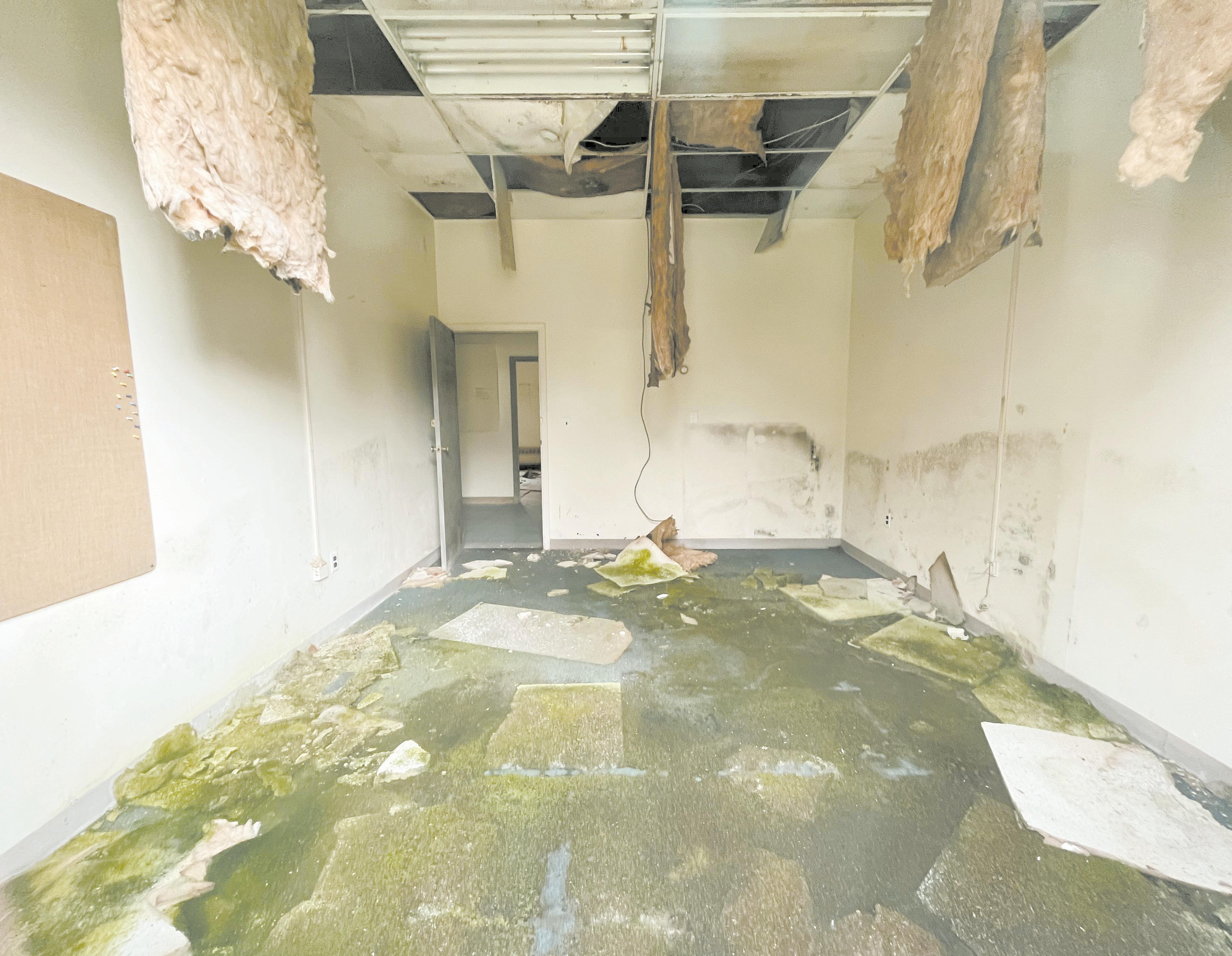
“You walk inside of the building and you see piles of animal feces and total disrepair there,” Thiele said. “You walk around to other buildings and see big red X’s on them.”
Southampton Hall is not out of place on campus — 17 other buildings are condemned with red X’s on the doors, including dormitories, academic buildings and even a former children’s school. Thiele said that these red marks are a visible indicator of the administration’s lack of commitment to the campus.
As part of the 2022-23 Fiscal Year State Budget, the New York State government created the Long Island Investment Fund (LIIF), a program that provides grants for eligible organizations with funding should they meet certain criteria. Colleges and universities are eligible to apply for funding, and the LIIF allows grants to be given out for “construction, expansion, and rehabilitation of facilities.”
Thiele was one of the state legislators involved in creating the fund.
In July 2022, Thiele and State Senator Anthony Palumbo wrote a letter to Stony Brook University President Maurie McInnis advertising the program and strongly recommending that the University applies for funding to renovate Southampton Hall. But, Stony Brook never applied for any funding that could be used for the Southampton Campus.
“So if nobody’s in charge and you don’t have a plan, and you’re not even willing to apply for grant money for something that you’ve already committed to on the campus, that tells me you don’t care,” Thiele said.
However, McInnis said that the reason the school did not apply to renovate Southampton Hall is because she was told they were not eligible.
“The funding that Assemblyman Thiele thinks we could have applied for was not appropriate for capital buildings, capital construction, that nature. So yes, we didn’t apply for it because we have been told there was not a match between the needs of that building,” she said.
In response to McInnis’ statement, Thiele sent an email to The Statesman stating that “the President is simply wrong.”
He said that renovating Southampton Hall did not fall under any of the categories of ineligible projects.

“The Southampton project may or may not have received funding, but we will never know because SBU chose not to apply, even though it had the support of the state senator and assembly member representing the campus,” he said.
In a statement to The Statesman, University officials said that they chose to apply for funding to build a new Quantum Internet Test Bed on the main campus in Stony Brook.
“The quantum testbed is a transformative project that we expect to create dozens of jobs and spur significant economic activity across the region,” the statement said.
The University received $6.5 million from the LIIF to build the testbed, an amount behind what smaller colleges with less research output had received from the same program.
Farmingdale State College received $30 million from the LIIF to build a Center for Computer Science and Information Technology, while Long Island University received $10 million to build a new facility for its College of Science.
Thiele also said that Stony Brook could have applied for federal funding for
the Southampton campus as part of the Fiscal Year 2023 Congressionally Directed Spending Requests process, but they failed to do so.
“They simply have shown no interest in meeting their responsibility to the Southampton campus and the greater East End community,” Thiele said. “Large portions of the campus continue to decay while McInnis fiddles.”
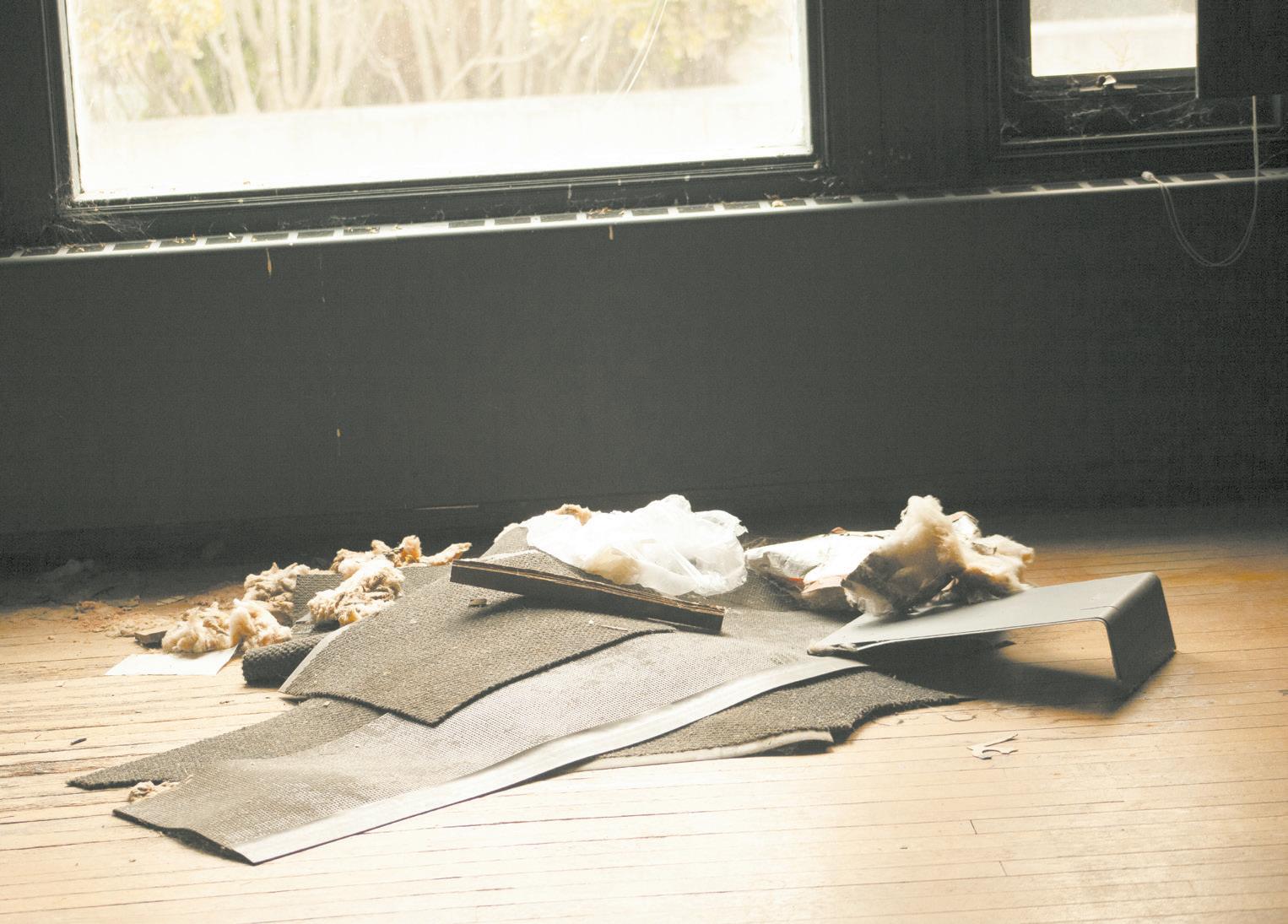
Thiele has his own ideas for the campus. He thinks the buildings can offer an affordable housing opportunity for graduate students and employees of Stony Brook or the coming hospital.
Stony Brook Southampton Hospital, located in the Village of Southampton, was supposed to be moved onto 15 acres of Southampton’s campus by 2022. But this was delayed until 2025 because of the COVID-19 pandemic, according to an article published by 27east.com.
“The hospital employs over 1,200 people, and there’s over 200 [job] vacancies,” Thiele said. “And of the people that work at the hospital most of them can’t afford to live on the East End. They have to commute long distances, and it’s been a real problem for the hos-
Thiele said that restoring these buildings would not only improve the appearance of the campus but address the dire housing needs of students and employees.
In a press conference with student media, McInnis said that while Stony Brook is committed to Southampton’s campus, renovating those buildings is not a priority right now.
McInnis said that the problem lies in deferred maintenance, which is the backlog of infrastructure repairs often delayed due to lack of funding. She said this is because virtually every building on both campuses is reaching its end of life at the same time.
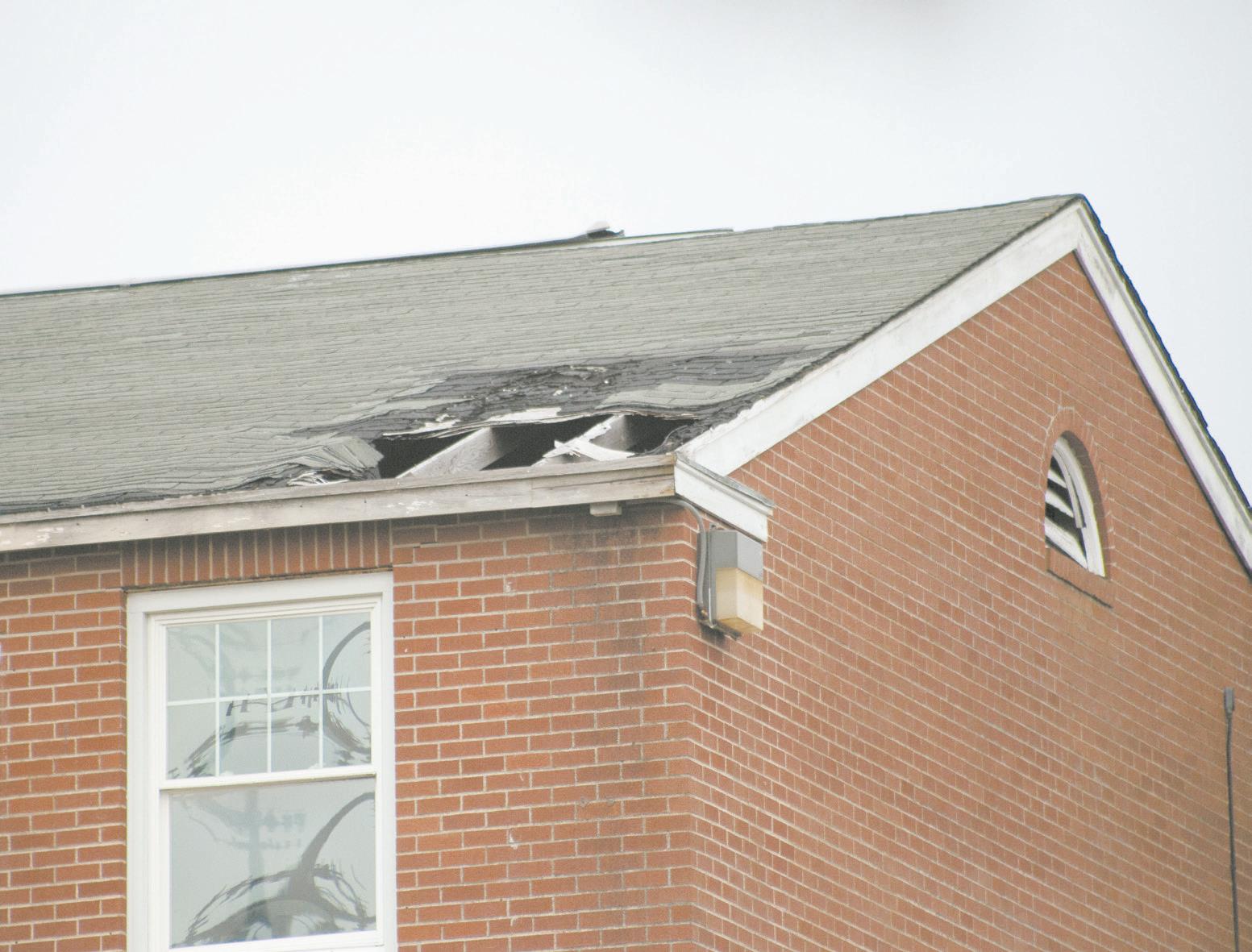

“We have $2 billion in what is referred to as deferred maintenance on our campus buildings and we do not control any of that funding,” she said. “This is another place where this state supplies the funding for buildings.”
McInnis said that Stony Brook has more deferred maintenance than any other SUNY school by threefold, with Buffalo as the next highest school with $600 million.
“We just don’t have the funding right now to be fixing all of the needs that we have on this campus and on Southampton, so we always have to prioritize,” she said. “We have a number of buildings that are on the queue to get renovated, and I have to say that the build-
Before Lauren Sheprow joined Port Jefferson’s Board of Trustees and ran for mayor, she was the head of Media Relations at Stony Brook University.
During Sheprow’s tenure at Stony Brook, she faced extensive criticism from the student media — including The Statesman — for her relationship with the student press. In 2019, The Atlantic reported that Media Relations under Sheprow were so hostile to students that she sat down with a Statesman reporter who castigated her for writing a factually correct but unflattering article about then-President Samuel Stanley. And that’s before a writer for The Stony Brook Press alleged that Sheprow and two other University officials publicly cornered a Statesman editor in Starbucks about an article reporting the layoff of more than 20 professors.
Earlier this April, we reached out to Sheprow about her tenure at Stony Brook. In less than a day, the former Media Relations official gave us a characteristically taciturn reply: “My schedule is kind of crazy these days — can you send me some questions and I’ll get back to you?”
We had already learned that Sheprow introduced a “Journalism Students Inquiry” form, which required student journalists to submit questions to the department before asking them. These forms often went unanswered.
So we asked Sheprow about her record in Media Relations. Five days later, she had not followed up with us. We shot her another email and received no response.
More than a week has passed since Sheprow’s punctual first email to The Statesman. Her initial instinct to reply quickly seems to have vanished.
This isn’t a new development. Dating from 1996 all the way to the unanswered Freedom of Information Law (FOIL) requests currently sitting in The Statesman’s inbox, we’ve found various incidents indicating Stony Brook’s poor track record in communicating with the student press.
Sheprow’s record speaks for itself. Yet, more importantly, the students she intimidated can speak for themselves.
Rebecca Liebson was The Statesman’s news editor in 2018 and 2019. She was the hapless young journalist who Sheprow cornered about her reporting. Now, she covers real estate for the Tampa Bay Times in Florida.
“I definitely miss covering the University,” Liebson said in a phone interview. “I’d love to cover higher education again at some point in my career … What goes down on a college campus really does reflect how our government works at large.”
Liebson was in her sophomore year when she covered a University Senate budget meeting. The meeting saw President Stanley address Stony Brook’s then-$35 million deficit. In her article for The Statesman, Liebson stated that “Stanley kept his head down for the majority of the meeting, both literally and figuratively, standing on the far left side of the room, his hands tightly clasped.”
“[Sheprow] called me into her office,” Liebson said. “But she wouldn’t tell me beforehand what she was summoning me for. So I went to her office, and basically, there was nothing factually inaccurate in the article. She just didn’t like that I said that President Stanley had his head in his hands.”
Stanley’s recent resignation as president of Michigan State University (MSU) following a failure to come clean about a dean’s misconduct allegations did not surprise Liebson.
“At the time, MSU was dealing with the Larry Nassar allegations,” Liebson said, referring to MSU’s women’s gymnastics coach who sexually abused hundreds of athletes.
“People at Stony Brook felt like Stanley had done so poorly at Stony Brook that [MSU] was really the only gig that he could get if he wanted to leave. There was always a sense that Stanley viewed Stony Brook as a stepping stone to get to a larger university.”
Stanley and Sheprow weren’t the only officials to dodge accountability. Sacha Kopp, former dean of the College of Arts
and Sciences, had a representative at the Starbucks meeting as well.
We reached out to Kopp, but his secretary told us there were more appropriate people to interview.
The history goes further back than a few years ago. A 1996 incident with Polity — now known as Stony Brook’s Undergraduate Student Government (USG) — resulted in the Supreme Court of New York stepping in to correct the Student Polity Association’s actions after it was decertified in 2002.
The Statesman was forced to sue Polity after the organization refused to follow FOIA protocol and release all contracts and paperwork pertaining to NIA Entertainment, a media consulting firm based out of Washington D.C. that was hired to assist 3-TV.
3-TV was a student-run television station that was revived in 1992 by Polity to give students the opportunity to get hands-on experience in television.
Since 1994, The Statesman had reason to suspect something was amiss between Polity and NIA Entertainment. Several sources alleged that the relationship was a conflict of interest when The Statesman had been investigating other incidents from Polity.
Polity’s argument for denying the FOIL request was that public disclosure laws didn’t apply to them since they were a “private organization.” State University of New York (SUNY) central supported Polity’s reasoning after The Statesman appealed, saying that they were a notfor-profit organization and not a state association.
In response, The Statesman filed a lawsuit on August 7, 1995. In January of 1996, Justice Vincent G. Bradley granted the FOIL request and mandated that Polity pay a percentage of the legal fees.
Unsurprisingly, the refusal to release the documents involved an individual that would have to face the consequences: Polity’s former President Crystal Plati. Plati secured the contract with NIA Entertainment but didn’t disclose her personal relationship with the head consultant at the firm and former Polity President David Greene.
The contract had suspicious origins and managed to evade many steps on the path for approval. After the contract had been faxed to Polity, it stated that it had been approved on two separate dates — but the minutes from those days neglect to mention any meeting. There was no evidence that NIA Entertainment was a legal corporation in either New York or Washington D.C. On the day the contract was faxed, 3-TV submitted a voucher for $3,000 that was approved the same day by Peter Baigent, the former dean of students. This was unheard of for clubs, and the way it was pushed quickly and quietly suggested that something scandalous was afoot.
Student journalists are workers – often unpaid ones. When the university administration attempts to exert power over us, our editorial independence is threatened. Declining to provide us with answers only adds insult to injury. Disturbingly, the administration can get away with it.
“Because fewer people read student media, the administration seems to feel less of a need to be accountable to them,” Liebson said. “But I think that dealing with that as a student journalist prepared me for the real world … Student journalists are faced with greater barriers than a professional journalist is.”
Which leads us to today. The new administration headed by Assistant Vice President of Communications Peter Thorne stated his team’s intentions when we reached out for comment.
“Our goal is to work collaboratively with the media, including student media organizations, to ensure that accurate and informative coverage is provided to the campus community and the broader public,” Thorne said. “By working together, we can ensure that information of interest to the university and the wider community is available in an accurate and timely manner.”
Only time will tell if the Media Relations team follows through on those intentions. However, those at The Statesman have an obligation to the student body to report on events in an accurate and timely fashion — we can only hope that our institution’s various administrations will assist us in that pursuit.
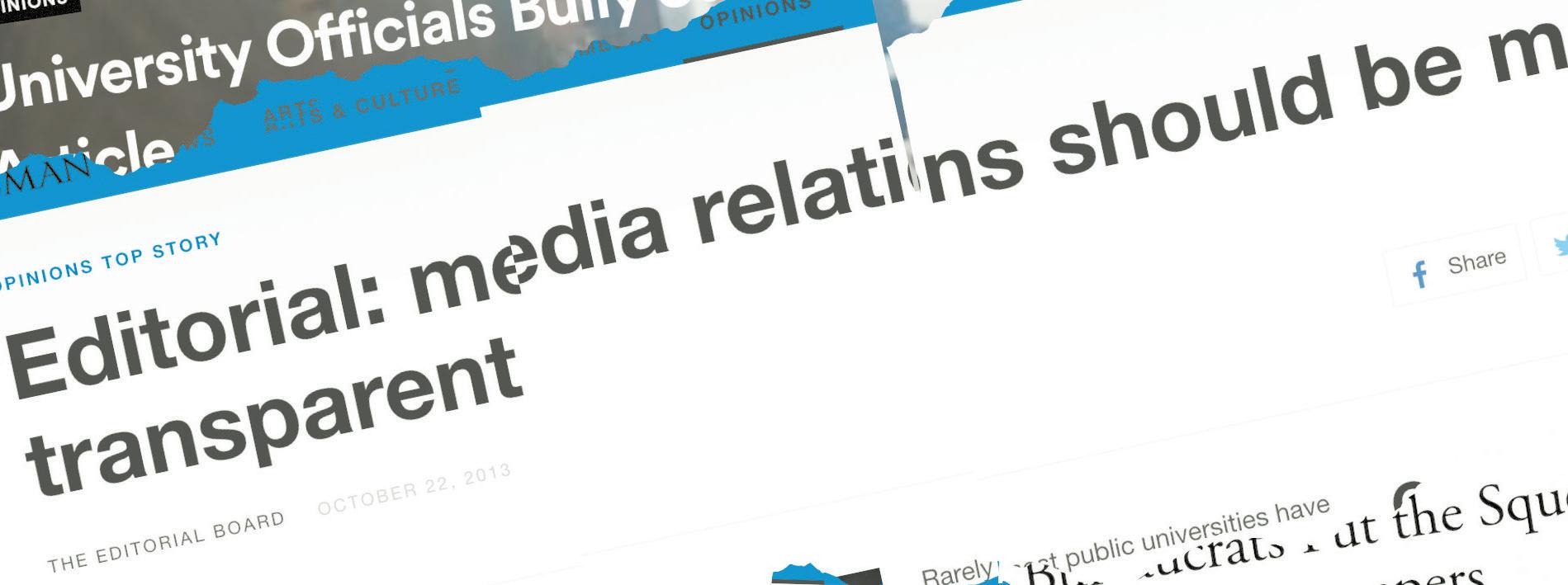
Stony Brook University President Maurie McInnis held a press conference with members of various campus media organizations on Feb. 27 to answer questions regarding the state of the University.
McInnis addressed the proposed 30% State University of New York (SUNY) tuition increase, parking changes, the CulinArt investigation, racist incidents on campus and other issues. The Statesman, The Stony Brook Press, Black World and The Stony Brook Media Group were in attendance.
Vacancies in faculty and staff
Based on their contract, it is mandated that faculty and staff salaries increase every year by a total of $10 million. There are over 400 vacancies between faculty and staff, which is how the school has been able to afford to adhere to the contract.
“You always have faculty leaving and you have staff leaving,” McInnis said. “There are a large number of them we just can’t fill.”
These vacancies take away opportunities from students, including class availability, advisors, mental health counselors and student support services. With these areas lacking in manpower, and possibly losing more people going forward, it will make it more difficult for students to graduate in four years.
Because of this, the tuition increase was proposed for the coming years.
Tuition
Back in February, Governor Kathy Hochul put forth a proposal that will allow New York’s research university centers, including Stony Brook, to hike tuition for in-state students by 30% over the next five years.
“Over the last 12 years, there have only been modest tuition increases,” McInnis said. “It means that we have had to pay for inflationary costs, the most significant of which are the contracted salary increases that are negotiated by the state and mandatory that we pay.”
The University is down almost 100 faculty and 300 staff members, which is why Hochul put forth a tuition plan that would provide steady increases over five years.
“You all are starting to feel that. That is really starting to have an impact on your experience,” McInnis said.
Funds offered by the Tuition Assistance Program (TAP) and Excelsior Scholarship Program will rise if tuition goes up, so those students still would not have to pay tuition — increased costs would be covered. Pell Grant financial aid from Stony Brook will go up as well.
The plan is to hire more faculty and staff. The State Assembly and the Senate will create budgets in response to Hochul’s plan, and then the final state budget will be negotiated amongst the governor, the Assembly and the Senate.
The increase still leaves Stony Brook thousands of dollars cheaper than in-state tuition of surrounding states, McInnis said.
Parking
On Feb. 10, Mobility & Parking Services (MAPS) sent an email to the Stony
Brook community that introduced a fully-paid parking model at Stony Brook. This is proposed to begin in the fall of 2023.
“We recognize that the proposed changes will have an impact on our community,” a MAPS representative wrote in the email. “However, the reality is that our current parking model is insufficient to fund routine maintenance or customer service improvements for our parking operations.”
The only money that can be put into parking infrastructure is money that comes from parking. This includes fixing potholes and providing light in the parking lots “so that these are safe places.” This is a SUNY policy that McInnis was unable to provide more information on.
The Statesman asked if MAPS approached the SUNY union about the new policy, and she responded that there are ongoing conversations between MAPS and SUNY unions, along with MAPS and students.
McInnis brought up that Stony Brook is “out of step” with other SUNY universities in terms of how little Stony Brook charges for parking.
“We are, by a longshot, way behind what others are charging,” McInnis said. “And many employers charge for parking. This is a common thing.”
She also mentioned that rates have not been raised in 30 years.
“We get complaints every day. Potholes in the lots, garages that are, we’ll just say, literally crumbling in front of our eyes … The only way we can move all of that is to raise the rates that we are charging for parking,” McInnis said.
The Undergraduate Student Government met with McInnis to discuss the parking situation, and they proposed to create a student advisory group that will provide a bridge between students and MAPS.
The President’s administration has agreed to having the student advisory group, and the process has been put into motion to set that up for next year.
More details on the proposed plan can be found on the MAPS website.
Graduate student protests
In the summer of 2020, the minimum stipend for graduate student employees was $20,000. By next October, it will be $26,000. Graduate students have previously needed to pay $1,800 in fees, which has been removed since McInnis took office.
But graduate students are continuing to push for higher stipends, as the current salary leaves them below the poverty line.
McInnis pointed out that the changes may not be everything graduate
students want, but she revisited the point about the “severe revenue challenges” the school has been facing.
“It is really a stretch for us to be doing what we’re doing,” McInnis said. “We will continue working with them, we will continue remaining focused on this. And we feel like we’ve made a lot of really significant progress in this most recent raise where it’s more than $3,000.”
In early February, a student accused her roommate of allegedly directing racist remarks toward her, and posted the accusations on Instagram. The post has since been deleted.
“It is enormously important to me that Stony Brook University is creating a welcoming, inclusive environment where students feel supported,” McInnis said when a reporter from Black World mentioned the incident. “Where we are listening to their concerns [and] we are responding to their concerns.”
She emphasized that it’s important that students utilize the official channels for reporting their concerns with related issues over social media.
CulinArt
In her opening comments of the press
conference, McInnis brought up allegations of misappropriation of state funds by CulinArt that The Statesman shone light on back in February. The Statesman obtained financial documents and emails proving that CulinArt used funds from the University to pay employees working at other locations, misreported how much they were spending on dining hall food and more.
“I want you all to know that we too are very concerned and troubled by the allegations that have been brought forward,” McInnis said. “And we will do everything we can to support this investigation.”
Due to it being an ongoing investigation, McInnis declined to say anything else. The president’s press staff did not allow her to respond to questions about the investigation asked by The Statesman
“An investigation is ongoing,” McInnis said. “And I will remain resolutely focused on making sure we have the right structures in place to make sure that we are providing the bes possible dining experience.”
During the press conference, McInnis said that she found out about the CulinArt scandal close to the time The Statesman published its article about it.

“Demand to hold SBU accountable. Title IX discrimination has become the norm on campus. Students are often left in the dark and silenced.”
This is one of many student messages that can be found on posters throughout Stony Brook University’s expansive campus. They call on students to share their experiences in a survey about the University’s Title IX office.
The seven students behind the survey met this semester in a class called “Democracy and Justice for All.” They were assigned to address an issue on campus — they decided on Title IX.
“We hope that our initiative will change how reports and the website are handled, along with policies,” freshman Zubair Kabir, one of the students on the project, said in an email to The Statesman. “Students should feel as though they are safe in classrooms, dorms, and on campus as a whole.”
Kabir runs the Instagram and TikTok accounts @hold.sbu.accountable as part of the campaign. Stony Brook caught notice of the posts and sent a direct message to the student-run account stating, “We were able to see that site visitors were able to access an old, unmaintained version of our Title IX page.”
The group is set to meet with administrators in early May to address their concerns, including the outdated website and lack of clarity surrounding the reporting process.
“I don’t believe Title IX at Stony is a complete waste, but there’s room for improvement,” Kabir said in the email. “And when the safety of students is in question, it’s important to not brush it under the rug.”
One student who filed a Title IX report in the fall 2020 semester had no complaints regarding her experience. But, as the former president of a sorority, she questions whether or not students view the Title IX office as an effective resource for their concerns. She knows members of her own sorority were hesitant to file reports after alleged incidents with fraternities, concerned they would not receive the help they were seeking.
“It seems like they are reporting these instances and nothing happens,” she said. “Granted, I don’t know. We’re not behind the doors.”
But what students think is happening behind those doors is ultimately what matters. If there is a negative view of the Title IX office, students may be less likely to file official reports.
In 2014, the University’s handling of sexual violence incidents was investigated by the Department of Education’s Office for Civil Rights, along with 75 other institutions. In 2018, The Statesman found that few Title IX incidents resulted in any action against the accused.
Now, Stony Brook has five open Title IX cases. Of these, two incidents were filed in 2017 and three in 2022. The five reports are two sexual harassment cases, denial of benefits, retaliation and “other.”
Christine Szaraz, survivor advocate and assistant director of the Center for Prevention and Outreach, said she has never seen an administration as communicative about
Title IX issues as Maurie McInnis’ staff. From previous administrations, there were “crickets.” After 15 years at Stony Brook, Szaraz says “The idea that we all have a role to play absolutely evolved here.”
The numbers
Title IX refers to the Education Amendments of 1972, which prohibits discrimination on the basis of sex in any education programs or activities receiving federal funding. As part of this, universities and colleges must have procedures in place for sexual harassment claims.
The Clery Act requires institutions of higher education to record their crime statistics, including sexual misconduct. Every year, Stony Brook’s Title IX office releases a sexual misconduct progress report that tracks the total number of reports filed in the past three years. It also breaks down that number by the type of allegation made.
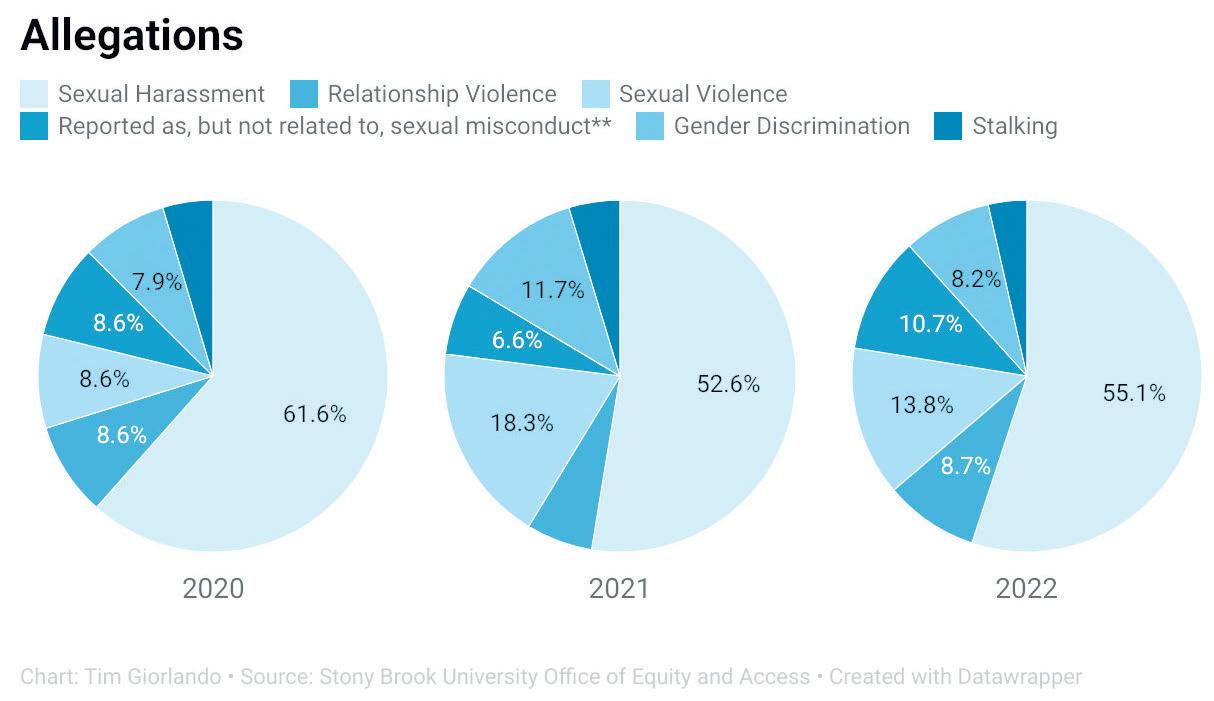
submissions from Stony Brook Medicine and third-party individuals such as guests, visitors or volunteers, potentially inflating the numbers.
What this means
Since June 2022, The Statesman has been analyzing Stony Brook’s Title IX data and seeking out expert opinions on the numbers. But Title IX data is hard to decipher — its nuances prevent experts from drawing conclusions based on numbers alone.
“The variability year to year of reporting is something that’s been mystifying to all of us in the field for a long time,” Sokolow said.
A high volume of reports can mean one of two things on a college campus: greater threat levels or increased accountability.
“Data is tricky — very, very tricky — when it comes to Title IX and what it represents,” said Amelia Barbadoro, the Title IX coordinator at State Universi-
reports, but added one more. There was also no change in the number of Title IX reports filed (Table 4).
This did not follow the expected U-shaped graph of schools like Binghamton and Buffalo. Through a lens of Title IX reports, it was as if COVID-19 never happened on Stony Brook’s campus.
“It definitely bucked the trend of most of what we were seeing from schools across the country at the time,” Sokolow said.
A data collection and comparison tool created by End Rape on Campus notes that numbers from 2020 were “irregular.” Stony Brook did not see any decrease.

One potential explanation for this is the isolation of the pandemic. Students may have reflected on their experiences — away from their perpetrators — and filed reports online for past incidents.
Or, like the former sorority president, victims were confined near their offenders. She filed her report after receiving aggressive, inappropriate messages from a classmate. Although she said the Title IX office was quick and calm in their response, she decided not to pursue a formal investigation because the perpetrator lived on the floor beneath her.
“He was just a very scary boy,” she said. “I did not want him to know that I had reported him.”
Students could also report incidents to Stony Brook’s survivor advocate. This is the only non-clinical and non-clergy confidential resource on campus, which offers support and information for victims without mandated reporting. Victims can ask questions and explore their options without having to formally report an incident if they are not ready to do so.
There is also no statute of limitations on reporting. But if a report is filed against someone who has graduated, the Title IX office cannot require them to take part in their investigation.
“We can’t compel them to participate in our practice and our process because there’s nothing to incentivize them,” Marjolie Leonard, Stony Brook’s Title IX coordinator, said. “It can be a struggle for that complainant because they feel like nothing is happening or can be done.”
This year’s report listed 177 incidents, a decline from the previous three years (Table 1). Sexual harassment was up 2.5% from 2021, relationship violence increased 2.6% and reports unrelated to sexual misconduct increased 4.1%. Sexual violence, stalking and gender discrimination all declined (Table 2).
“You’ve got numbers that I would see more commonly in a school of 40,000 to 50,000,” said Brett Sokolow, president of the national Association of Title IX Administrators, based on anecdotal information through his work. Stony Brook’s enrollment for the fall 2022 semester was 25,710.
But the data may also include reports from Stony Brook University Hospital. The sexual misconduct report form accepts
ty of New York (SUNY) Albany. “Truthfully, I can’t tell you if there’s more or less incidents. I’m not there at every frat party.”
Clery numbers also account for all reports filed, regardless of when the reported incident occurred, if it was substantiated or if the case was dropped.
A noteworthy reporting trend occurred when the pandemic struck. SUNY Universities Albany, Buffalo and Binghamton saw significant decreases in the number of reported on-campus rapes when less students were dorming in 2020 (Table 3).
But Stony Brook was different. Despite there being 56% less students living on campus in 2020, the University not only maintained the number of
If students are unsure what constitutes a Title IX case, or what resources are available to them, they are less likely to file reports. New York universities are required by state education laws to survey their students and staff about the prevention of sexual violence at least once every other year.
Stony Brook’s most recent survey results from 2021 found that 94% of students were able to identify on-campus resources for sexual assault, and 74% knew how to report sexual violence to the University.
But the survey only had a 9% response rate. Out of 25,596 surveys sent, only 2,335 students responded.
Title IX incidents are grossly underreported across the country. The Rape, Abuse & Incest National Network (RAINN) found that only 20% of college-age female students report sexual assault to the police, and 32% of non-student females file reports.
Continued on page 7
The data is complicated — multiple factors are taken into consideration when collecting, reporting and analyzing these numbers. But with these nuances in mind, action can still be taken to improve Title IX issues on college campuses.
Culture of accountability
In 2022, the Office of Equity and Inclusion created a five-part Title IX task force to make recommendations for the response and prevention of sexual misconduct at Stony Brook. All of the groups stressed the need for in-person training and increasing the amount that is currently offered.
“We are aware that with our current times, for a lot of people the convenience factor is online,” Leonard said. “We have 26,000+ students, 15,000+ employees, there’s no way we could get in front of everybody.”
Stony Brook requires an annual ReportIt. training module for University employees, student leaders and athletes. New degree students — whether incoming freshmen or transfers — are only required to complete the training once.
The online presentation covers Title IX reporting through video segments and
content checks. Although the videos cannot be skipped through, the content checks can be repeated until all questions are answered correctly. The only consistent engagement is clicking to the next part of the presentation when a video is completed.
But student completion did increase over the past three years, rising from less than 75% in 2020 to over 80% in 2022 (Table 5).
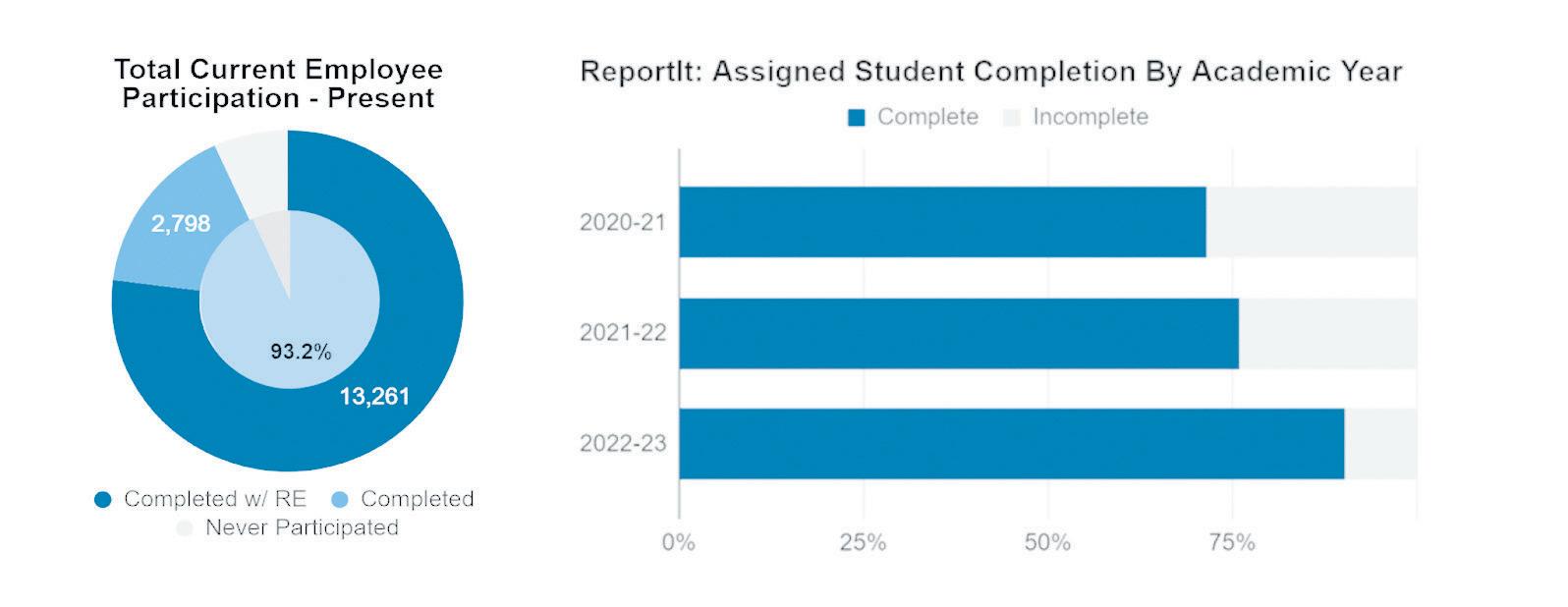
Leonard said that because the ReportIt. training is built in-house by the Title IX office, chang es take more time to implement.
“It’s not something that can just be edited and changed within a few weeks,” Leonard said. She affirmed that Stony Brook’s training is up to date with the most recent regulations and information.
At SUNY Albany, Barbadoro tries to switch up training about every four years. Some years she does the presentation herself, and other years the school hosts informative performances.
“What’s effective with that approach is that they’re getting the information in different ways,” Barba doro said. “It’s not redundant.”
Albany saw reported rapes consistently decrease between 2019 and 2021, unlike Stony Brook.

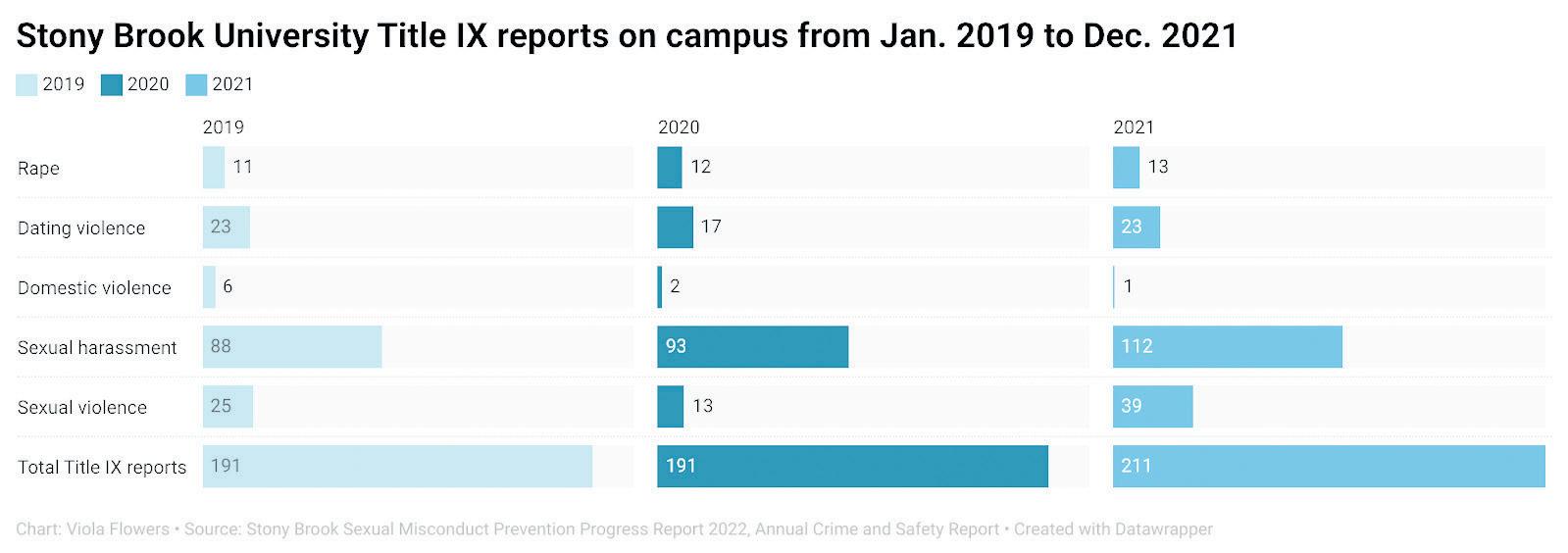
“The number one reason why our numbers would go down is that we have a culture of accountability,” Barbadoro said.
But with 10,000 more students than Albany, Leonard said in-person training at Stony Brook is dependent on demand. If specifically requested, the Title IX office will coordinate with the inquiring group to provide an in-person training session.
“Over the years we’ve increased the amount of training that we’ve done,” Leonard said. “Our goal is to empower people to feel comfortable coming forward and being aware.”
Social media
Online platforms are a rapidlygrowing outlet for students to share their Title IX experiences, especially with student-run and organized social media accounts like @hold.sbu.accountable.
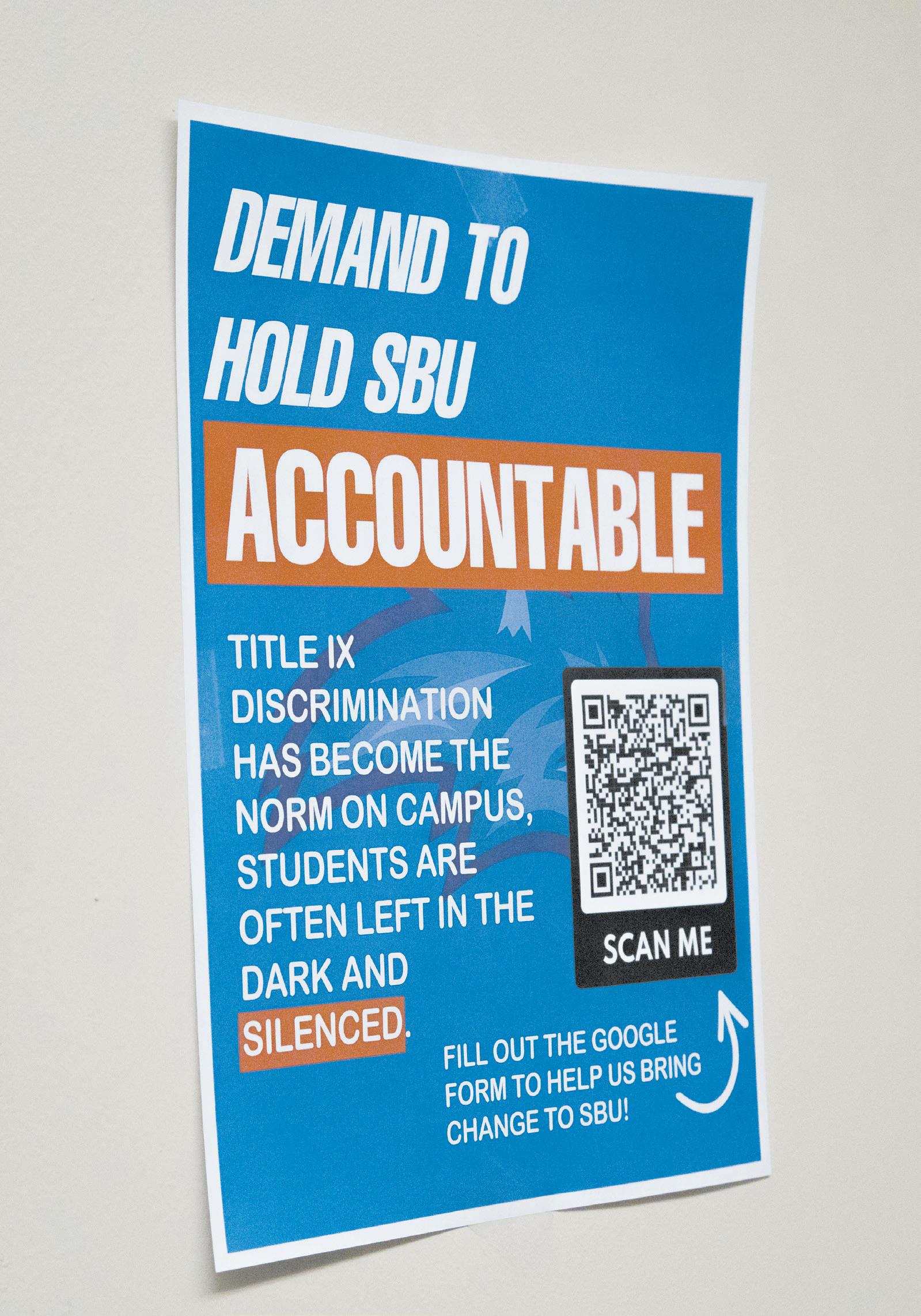
Back in 2020, three fraternities were suspended after sexual assault allegations surfaced on multiple social media platforms. In September 2022, the Sigma Phi Delta fraternity was placed on interim suspension after an Instagram post accused members of sexual assault.
“It’s a messy culture because you keep
how Title IX is doing nothing,” the former sorority president said. “Girls and guys always have to run to Instagram or social media because we won’t be heard unless we do.”
The University Police Department has social media accounts that directly reach out to individuals who post about their allegations.
“Students are very proactive in helping their fellow students and making us aware of situations where we can provide assistance,” said Neil Farrell, assistant vice president for compliance, investigations and accreditation at Stony Brook. “I think that really speaks to the University creating a culture that we’re all in this together.”
But President McInnis encourages students to report their experiences through University resources rather than online platforms.
“Social media is rarely the productive place to get this work done, or [for] Stony Brook University to be informed,” McInnis said in a press conference with student media that addressed all issues on campus. “We really hope students, whatever their concerns are, will raise them with official channels as well.”
The students do not agree.
“We are the social media generation,” the former sorority president said. “You shouldn’t have to scream from rooftops to
After the Stony Brook men’s basketball team endured its worst year since the 200708 season, rumors circulated surrounding head coach Geno Ford’s job security. But according to Athletic Director Shawn Heilbron, Ford is the long-term solution. He will have his job for at least two more seasons.
After serving as the associate head coach at Stony Brook for three years, Ford was named interim head coach in March 2019 once head coach Jeff Boals resigned to accept the same position at Ohio University. On March 26, 2019, Heilbron removed the interim label and promoted Ford to head coach.
That day, Ford signed a five-year contract that runs through March 31, 2024. His contract permitted him to start negotiating an extension with Stony Brook at the end of the fourth year, which was this past season. In an interview with The Statesman on Oct. 27, Ford said that the two sides had not yet entered negotiations.
Heilbron confirmed the same thing in an interview with The Statesman on Nov. 21. “I really want Geno to be successful because I think he’s a really good coach,” Heilbron said. “But we’ve got to have success. We have to be good in basketball, and I’ll leave it at that.”
In a follow-up interview on March 30, Heilbron said that the sides have still not entered contract talks, let alone reached an extension. However, he gave Ford his vote of confidence.
“Right now, the goal is on having the championship team on the court next year
that we expect to have,” Heilbron said. “Geno and his staff are working really hard with that. I believe that Geno is going to be our coach for a long time.”
Though Ford has not been extended, that does not mean he is a lame duck. As a State University of New York (SUNY) employee, Ford is protected by the union. If Heilbron wanted to part ways with Ford, he would have needed to issue him a notice of non-renewal by March 31, 2023. Employees who are not given a non-renewal automatically get to retain their position and get renewed for a year.
On the court, Stony Brook had a bad 2022-23 season. In the team’s first season in the Colonial Athletic Association (CAA), it finished 11-22 overall and 6-12 in conference play. Two of those wins were against non-NCAA Division I teams. Stony Brook finished in 10th place and was eliminated by Charleston in the second round of the playoffs. Injuries to several star players and key acquisitions played a role in the team’s demise.
Given the hand that Ford was dealt by the injury bug, Heilbron was impressed by the coaching job that he did and decided not to non-renew him.
“We’re coming off of a season that didn’t meet our expectations from a record standpoint,” Heilbron said. “There are obvious reasons for that, and I think we can look at the injuries. Geno and his team are doing a great job. I think even with the record last year, I thought they really coached and got the most out of this team.”
It is still possible that the two sides agree on a contract extension during the final year of Ford’s current deal. One thing that is certain: Ford will be back after next season ends due to the decision to not non-renew him.
In a follow-up interview on April 12, Ford confirmed that he did not receive a notice of non-renewal. He too expects to be on the sidelines at Stony Brook for the long haul.
“I’ve enjoyed every day that I’ve been at Stony Brook going on eight years,” Ford said. “I certainly hope that I’m here another seven or eight years. We need to win enough to justify that happening; that’s the business. So we need to win more. I think that’s something that’s going to play out and I’m not concerned about it, that’s for sure.”
Ford entered this past season with a winning record, but he now sits at 58-63 all-time with Stony Brook. With key players returning from injury and one year in the CAA under its belt, the team will hope to take a big leap in the 2023-24 season. Based on what Heilbron has said, a big year next season could finally land Ford an extension. Mike Anderson contributed reporting.
This past academic year, questions were raised regarding the contract situations of two head coaches of marquee Stony Brook University teams. Chuck Priore of the football team was quietly given a three-year contract extension back in June 2022, while Geno Ford of the men’s basketball team is now entering the final year of his current contract.
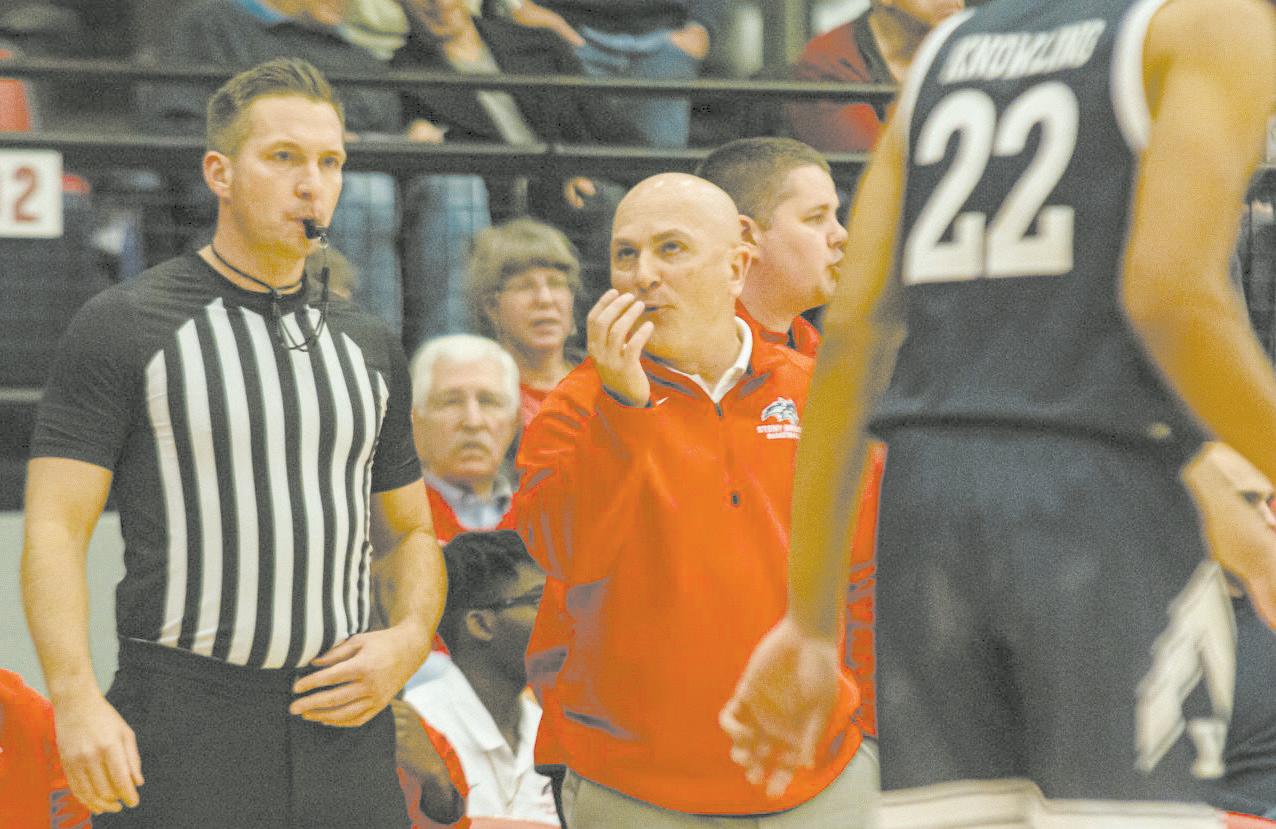
The irony in it all is that Director of Athletics Shawn Heilbron — the man negotiating these contracts —is working without one himself.
According to a copy of Heilbron’s contract obtained by The Statesman in a Freedom of Information Law request, Heilbron was given a three-year contract extension by former university president Samuel Stanley in July 2019. The extension kept Heilbron under contract through June 30, 2022. Current university president Maurie McInnis did not extend Heilbron’s contract before it expired.

Though Heilbron has not been extended, that does not necessarily mean that McInnis is planning to remove him from his position. Employees of Stony Brook University are employed under union guidelines, which protects them from abrupt firings. If the institution wants to get rid of a contracted employee, it must issue them a notice of non-renewal at least one year before their contract expires.
McInnis opted not to do that, allowing Heilbron to return for this year as the school’s athletic director without a long-term contract.
Since Heilbron is returning by default and not via extension, he is serving under the same conditions of the previous contract. The contract pays him $340,000 per year, plus incentives for accolades and accomplishments of both himself and the department.
In an interview with The Statesman on March 30, Heilbron confirmed that he does not have a contract for the future, but is optimistic that the situation will be resolved.
“I’ve spoken with the president about it,” Heilbron said. “I feel very confident in how we’re proceeding. It’s something that we’ve discussed. She’s been incredibly supportive of me and our department so honestly, I’m not overly concerned about it.”
It remains unclear why Heilbron has not been extended. He attributed it to busyness on behalf of both McInnis and himself.
“It’s something that we’ve talked about and quite frankly, there’s a lot going on,” Heilbron said. “I’m focused on running the department; she’s focused on running the University. My focus is day-to-day. I put the pressure on myself everyday. Our path is very much right in front of us and I really appreciate her support. We’ll get around to an extension.”
Heilbron was hired in the spring of 2014 as the successor to former athletic director Jim Fiore, who was fired in November 2013 due to sexual misconduct allegations. Heilbron officially assumed the position on July 1, 2014.
During his time, Stony Brook has reached new heights. The department won its firstever America East Conference (AE) Commissioner’s Cup in the 2018-19 academic year before repeating in 2020-21. In January 2022, Heilbron helped land an agreement to move Stony Brook to the Colonial Athletic Association (CAA) — a deeper conference with generally higher Rankings Power Index numbers.
On the field, Stony Brook has had some success under Heilbron as well. The women’s lacrosse team achieved the school’s first-ever No. 1 ranking and has become a perennial top-10 team nationally. The baseball team has been to two NCAA regionals (2015 and 2019) while also winning four regular season titles in that span. The football team made the playoffs in 2017 and 2018. The men’s basketball team made it to the NCAA Tournament for the first time ever in 2016, and the women’s basketball team accomplished the same feat in 2021. The women’s soccer team made it to three NCAA tournaments in a four-season span (2017, 2019, 2020-21).
The women’s volleyball team made it to backto-back NCAA tournaments in 2017 and 2018.
However, things have not entirely been trending upwards for Heilbron and Stony Brook Athletics. Since the start of the new decade, only the women’s soccer, women’s basketball and women’s lacrosse teams have made it to the NCAA Tournament. The football team is mired in a four-year
playoff drought and is coming off its worst season ever by record.
The move to the CAA has been hard on just about all of the other teams except for the men’s cross country team, both lacrosse teams and the women’s basketball team.
Though the University has not yet made a long-term commitment to Heilbron, he said that his motivation to win right now is not contract-driven.
“I always feel the pressure, whether I have a five-year contract or a five-day contract,” Heilbron said. “There’s such a finite amount of time that we have to do this. But, I feel pressure every day to win. I want to win every year no matter what the situation is.”
The University did not immediately return a request for comment.
McInnis has not publicly spoken about Heilbron’s contract situation or potential future with Stony Brook. As of now, only time will tell what the University’s president decides to do with the head of her athletics department.
Head coach Geno Ford on the sideline in a game against Yale on Saturday, Dec. 3. TIM GIORLANDO/ THE STATESMANStony Brook University professor Anna Hayward faced threats from elected officials and the Suffolk County Police Benevolent Association (PBA) regarding controversial social media comments she made about a police-involved shooting.

On Dec. 28, 2022, the social welfare professor commented on a post made by the Stony Brook Medicine Instagram account regarding two Suffolk County police officers. The officers were taken to Stony Brook University Hospital with stab wounds after a confrontation with a suspect, Enrique Lopez.
Lopez left one of the officers with lifethreatening wounds before he was shot in selfdefense, according to police. He lived in a home for people with disabilities or mental illness.
“This was a wellness check — why didn’t they de-escalate the situation?” Hayward posted. “Why did a man have to die? What about the man they murdered?”
Hayward’s comments made headlines in the New York Post and other publications, along with threatening emails and phone calls directed towards her.
“The same night I started receiving threatening emails on my Stony Brook account ... one of them was actually a city official who changed to his personal account, but the first time he wrote to me was on his official account,” Hayward said. “In the threatening email, they said that they were going to share my information with the largest brotherhood in the country, which was law enforcement.”
The Suffolk County PBA, a police advocate group, made their own Instagram post about the situation on Jan. 2.
“Stony Brook University must denounce Hayward’s hateful comments and should put an end to the harmful anti-police bias in their program,” they wrote. The Suffolk County PBA declined to comment on this article.
“I had all these texts from people at work that were like, ‘Are you okay?’ Because somebody had written an email and sent it to everybody in my school that said, ‘I hope somebody comes to your house and slits your throat,’” Hayward said.
Stony Brook University Professor Dr. Anna Hayward displayed a stunning level of ignorance when she callously commented on Stony Brook’s official page condemning the actions of these hero cops who stopped an armed criminal and saved others from harm.
After the Suffolk County PBA’s post, Stony Brook released a statement which said that “the incendiary language used by this faculty member was inappropriate and does not
correspond to the reported facts of the incident.”
Hayward said that once the statement was released, all the threats she was receiving stopped immediately.
“They made the statement and the threats stopped, but they have never said to me that those two things are connected,” Hayward said.
Charlie Robbins, a professor in the School of Social Welfare and founding director of the Center for Changing Systems of Power, shares similar views.
Hayward agrees. “Maybe they shouldn’t have said anything. That’s an option that they had, but they chose to make a statement,” she said. “I was just really sad and disappointed that my university didn’t have my back.”
Mitchel Cohen, a 1975 Stony Brook alumni, stated that this was not the first time that the University did not support their faculty members.
“Stony Brook University has a long history of collapsing under pressure of repressive forces,” Cohen wrote in an email to The Statesman
it up to radical students to physically defend Professor Dube from outrageous racist attacks and outright death threats,” Cohen wrote.
Some of the panelists and community members believe that the Suffolk County PBA had no right to have posted about Hayward’s comments, and that the University once again failed to protect one of their own.
In response to the backlash, a group of eight faculty members held a teachin about the policing of free speech at Stony Brook University on March 23.
Josh Dubnau, a professor in the Department of Anesthesiology, stated at the teach-in that “the idea that the police view themselves as above criticism by civilians, the fact that they would threaten a public university and the fact that the university would so easily capitulate: Those facts should be chilling to all of us.”
“When administrators choose to call out [the comments on social media] as incendiary and inappropriate — those were the words that were used — they undermine academic freedom,” said Jeffrey Heinz, a professor in the Department of Linguistics and Institute for Advanced Computational Science, during the teach-in.
At the event, it was mentioned that Hayward’s personal information — including her email, phone number and home address — was shared to the public through the comment section of the Suffolk County PBA’s post.
“She should have never been publicly reprimanded in the way she was and treated, in my opinion, without any consideration of what was happening to her nationally, as well as to her family,” Robbins said.
Deputy Director of Communications Kelly Drossel said in email to The Statesman that “University officials acted in a careful and thoughtful way that fully respected professor Hayward’s First Amendment rights while at the same time exercising our right to disagree with her characterization of the events.”

Drossel also wrote explaining that, “everybody in the administration was engaged and deeply concerned about professor Hayward’s safety, and we took steps from the very beginning to increase security for her on and off campus and the campus as a whole.”
However, some faculty members disagree.
“The simplest course of action is to not say anything. University officials could have worked to secure Dr. Hayward’s safety while ignoring the request to jump when the PBA said to jump,” Heinz said.
In the 1980s, Ernest Dube, a professor hired by Stony Brook in 1977 to teach African studies who was imprisoned in South Africa alongside Nelson Mandela, had a similar experience to Hayward when he made a controversial comment in his lecture.
Dube discussed overt, covert and reactive racism in his lecture, during which he gave the topic “Zionism is as much racism as Nazism was racism,” to his students for their term paper. A student complained that “[Dube] advanced in ideology without encouraging debate and bullied those who disagreed,” according to an article the New York Times released in 1983.
When that student disagreed with Dube about a comment he made about Israel, the student claimed that Dube screamed at him; however Dube did not have any memory of the argument.
“Instead of defending Prof. Dube’s right to ask provocative questions of his students, the University threw him under the bus and refused to renew his contract, leaving
“I was shocked that our University leadership was making a statement to condemn her at the very same moment she was being threatened,” Crystal Flemming, a professor in the Department of Sociology, said. “Because what does it mean to live in a society where the police dictate what we’re allowed to send, and where they can call up your employer and say, ‘you know what, we want you to condemn this woman’s speech.’ And they do it.”
In response to what happened to Hayward, students, staff, faculty, alumni and colleagues from other State University of New York (SUNY) institutions wrote an open letter signed in her defense. The group of eight faculty members who were at the teach-in panel also listed five requests from the administration to be met by March 1 — they still have not been met.
“It was a terrifying time for me because I knew there were these people out there that were so angry at me and I didn’t know what they were capable of,” Hayward said. “I was living in a state of fear and terror and I was disappointed with the university. It felt that they kind of threw me to the wolves.”
Editor-in-Chief.................Jeremy Portnoy
Managing Editor.......Katherine Procacci
Managing Editor.................Viola Flowers
Managing Editor...............Maria Lynders
News Editor...................................................Lori Saxena
Sports Editor...........................................Mike Anderson
Opinions Editor....................................Christine Kelley
Multimedia Editor..................................Tim Giorlando
Copy Chief......................................................Skylar Sena
Audience Engagement..............................Alissa Pabon
Asst. News Editor...................................Sonya Gugliara
Asst. Arts & Culture Editor........................Jenna Zaza
Asst. Sports Editor......................................Matt Howlin
Asst. Sports Editor.................................Kenny Spurrell
Asst. Opinions Editor..........................Anya Marquardt
Asst. Opinions Editor.................................Sara McGiff
Asst. Multimedia Editor.........................Brittney Dietz
Asst. Multimedia Editor.........................Camron Wang
Asst. Copy Editor..........................................Olivia Erndl
Asst. Copy Editor..................................Alyssa Pascocello
Asst. Audience Engagement...................McKenzie Post
To contact the Editor-in-Chief and Managing Editors about organizational comments, questions, suggestions, corrections or photo permission, email editors@sbstatesman.com.
The Statesman is a student-run, student-written incorporated publication at Stony Brook University in New York. The paper was founded as The Sucolian in 1957 at Oyster Bay, the original site of Stony Brook University. In 1975, The Statesman was incorporated as a not-for-profit, student-run organization. Its editorial board, writers and multimedia staff are all student volunteers.
The Statesman and its editors have won several awards for student journalism and several past editors have gone on to enjoy distinguished careers in the field of journalism.
Disclaimer: Views expressed in columns or in the Letters and Opinions section are those of the author and not necessarily those of The Statesman
For more Statesman content, visit us at sbstatesman.com and follow us on Twitter and Instagram @sbstatesman.
Since the COVID-19 pandemic, the mental health of college students has suffered. According to the American Psychological Association, over 60% of college students met the criteria for one mental health problem between 2020 and 2021. This increase in mental health issues has coincided with an increase in media consumption.
A study conducted by Vividata took a detailed look at the increase in media consumption by college students. Sixty percent of respondents reported that their media consumption levels rose during the COVID-19 pandemic, with a 60% increase in social media usage, 40% increase in audio/music usage and a 41% increase in video usage.
So, we at The Statesman wanted to take a look at how this increase in music and media consumption could possibly be linked to the mental health issues currently facing college students today. In order to do so, we put out a Google Form survey to students at Stony Brook University asking them about their mental health during the academic year, as well as their music and media consumption. Our results are detailed below.
Before getting into music and media consumption, we wanted to take a look at the mental health of Stony Brook’s students. Speaking on their overall mental health, 48.9% of respondents reported their mental health declined during the 2022-2023 academic year, while 35.6% stated that it improved and 15.6% believed that their mental health remained the same as the previous academic year. Mental health resources (either on or off campus) were utilized by
35.6% of our respondents, while 64.6% did not receive some sort of mental health help.
On the topic of academic workloads and burnout, we saw massively skewed results from our survey. A resounding 84.4% of respondents stated that they have suffered from academic burnout this academic year. Academic burnout is defined as “occurring when you face chronic stress over an extended period of time, manifesting in apathy, fatigue, detachment, and lack of interest in academics.”
This percentage falls steadily in line with the 80% who reported feeling “overwhelming stress” in The National College Health Assessment. This wasn’t much of a shock, given that the previous question, asking students to rate their workload on a scale of one to five (with five being the heaviest workload), resulted in 97.8% of respondents having a workload of three or higher.
We concluded our mental health section by asking our students if they believed Stony Brook did a good job in supporting students’ mental health. A resounding 71.4% reported that Stony Brook did not.
Music
It didn’t take much observation of our results to see the impact music has on our respondents. Music seemed to be the easiest choice of media for students to put on when they are in a stressed or anxious state. 86.4% of students said that listening to music improves their mental state.
A whopping 75.4% of our respondents listen to six or more hours of music per week. Our top genres were pop (71.1%), rock (66.7%), alternative (66.2%) and indie (51.1%). We also saw a plethora of other genres, including Broadway, lo-fi, R&B, rap, K-pop, classical and instrumental. Our most
listened-to artists included The Beatles; Taylor Swift; The 1975; Hozier; Doja Cat; Harry Styles; SZA; Tyler, the Creator; and Phoebe Bridgers. Some of the key words we saw in the explanations of why people enjoy these artists and this music included “emotional,” “motivating,” “upbeat,” “comforting” and “calming.” Many respondents also said they looked for music with a “deeper meaning” or a social commentary/connection behind it. Another key word we saw was “nostalgia” — students looking to listen to an artist, genre or song that evoked familiarity in order to evoke feelings of calmness or serenity. When talking about what impacts their choice of music, answers varied based on everyday tasks and occasions. Some said they listen to music most when they’re at the gym or going for a run. Others spoke of having music to calm them down or evoke a relaxing feeling before bed. A large number of respondents spoke of the importance of having music to listen to while studying — showing how school can never truly leave our subconscious.
Other Media
Unsurprisingly, 65.9% of our respondents spend six or more hours per week streaming content, which was defined as consuming media from platforms such as Netflix, YouTube and Disney+. Streaming sites and services appeared to be more popular amongst respondents than social media, as only 47.7% of respondents reported spending six or more hours per week on social media.

When asked to list the television shows they are currently watching, many respondents resorted to the same nostalgia that was evoked in their music choices. Popular shows amongst respondents included
Continued on page 11
sitcoms like “Parks and Recreation” and “The Office,” as well as reality shows like “Dance Moms,” which were cited as being “comforting” to watch. Many respondents said they are rewatching shows, further illustrating the desire for comfort in media, as students are choosing to watch shows that are familiar and repetitive.
“I have long used TV as a coping mechanism, I’ve watched some series as many as 10+ times and I’ll still rewatch them [because] the repetitiveness and knowing how things will end relieves my anxiety,” one respondent said.
Some respondents noted that watching television is a “distraction” from the daily grind, which also corresponded to the television programs they chose. While none offered specific titles, many respondents listed anime as their current television consumption genre — other animated content like “Family Guy” and “SpongeBob SquarePants” also frequented participants’ screens. Such content offers participants a fictitious escape from reality, with one participant noting

that “hilarious writing and nostalgic connection” provides an escape.
The tendency towards more fictional content continued with the frequent mention of “The Last of Us,” HBO’s timely post-outbreak drama series. While it may be in part due to
put on in the background while they complete other tasks, such as schoolwork. This media multitasking mirrors the increase in college students’ study time over the last decade, as observed by the 2020 National Survey of Student Engagement.
stated that spending time on social media worsens their mood and mental state. Not only is social media an agent of upset for respondents, but it is also their outlet of choice when they’re already in a negative mood. Nearly half of respondents said that being on social media worsens their mood and mental state, with only 28% noting that they spend less time on social media when upset.
Conclusion
its recency, the show’s popularity amongst respondents further showcased the preference by participants to sink into another world.
For many respondents, watching television is only one part of their daily equation; participants frequently mentioned watching shows that they consider “mindless” and that can be
While television may have offered participants some reprieve from their daily stressors, various respondents shared the view that social media only exacerbates it. When it comes to social media sites like Instagram, Snapchat and TikTok, more than half (53%) of respondents
Overall, respondents showcased that media is an important tool for college students struggling to fight stress and academic burnout in their daily lives. Students are turning to more professionally-produced content such as television and music as a more positive form of stress relief compared to content created by the general public on social media and video-streaming applications like TikTok. Compared to other forms of media consumption, such as social media and streaming, music and television offer students more of an escape from their daily lives and provide them the comfort and nostalgia they so desperately crave.
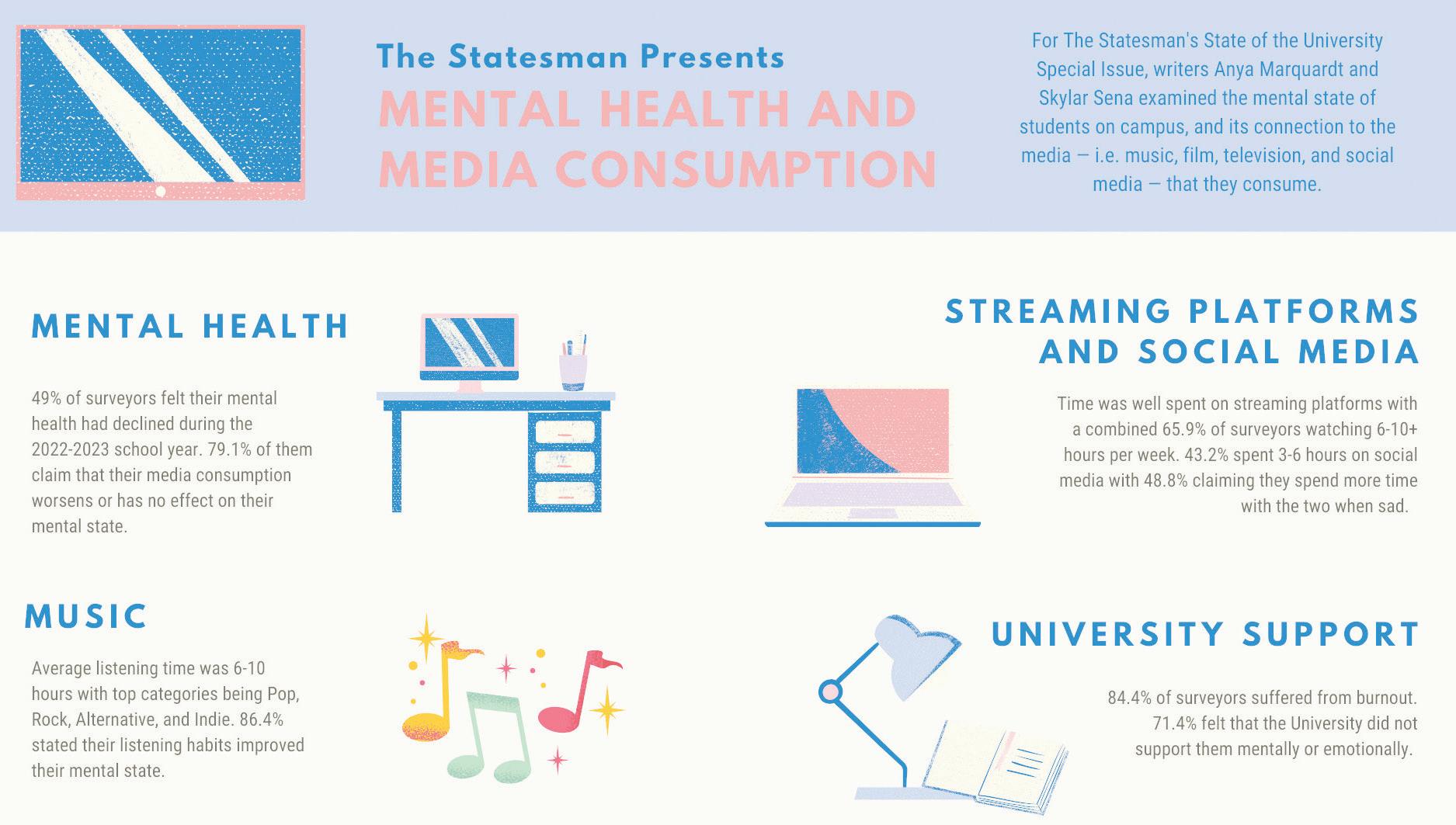
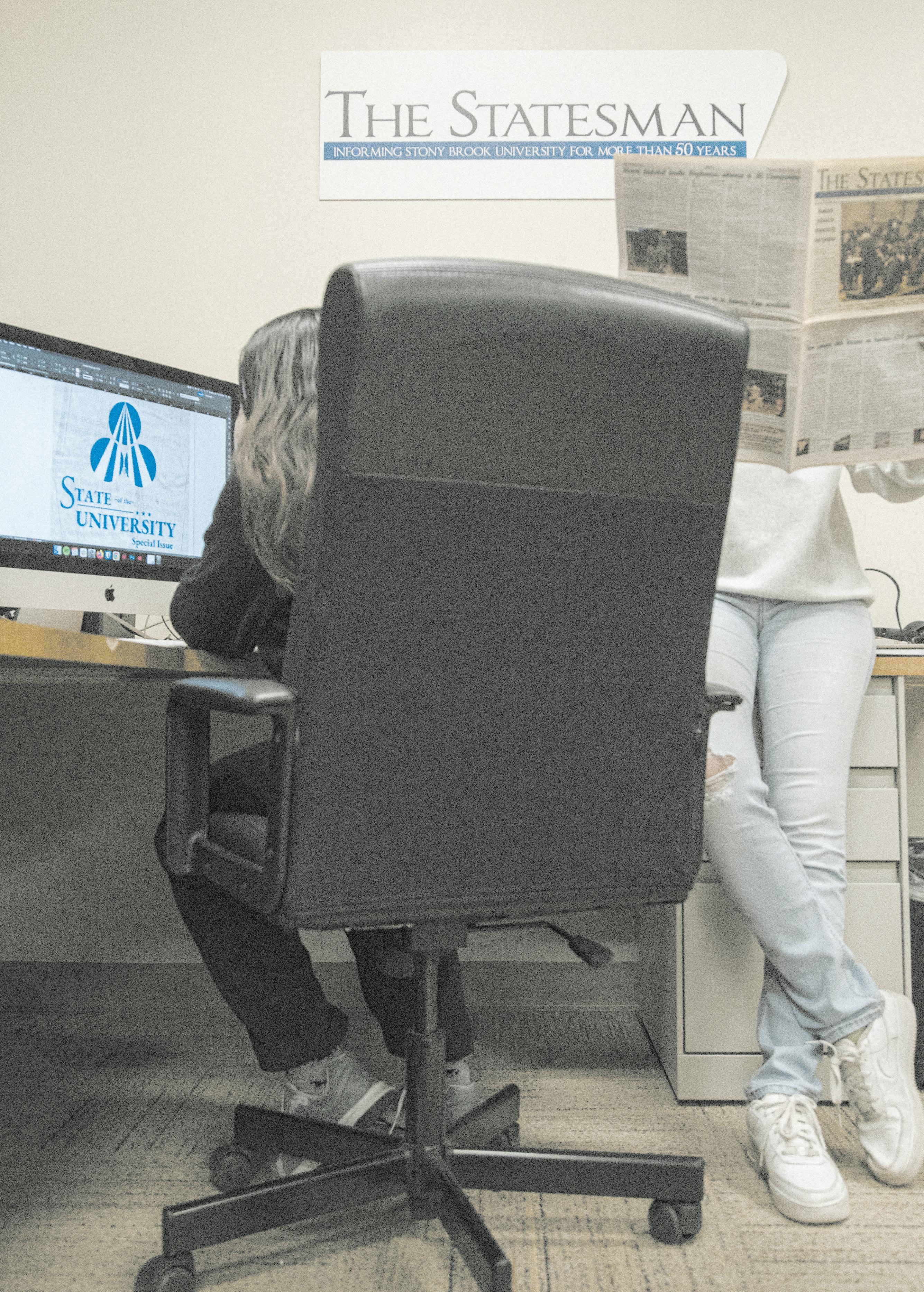 Design by: Viola Flowers
Katherine Procacci
Tim Giorlando
Design by: Viola Flowers
Katherine Procacci
Tim Giorlando